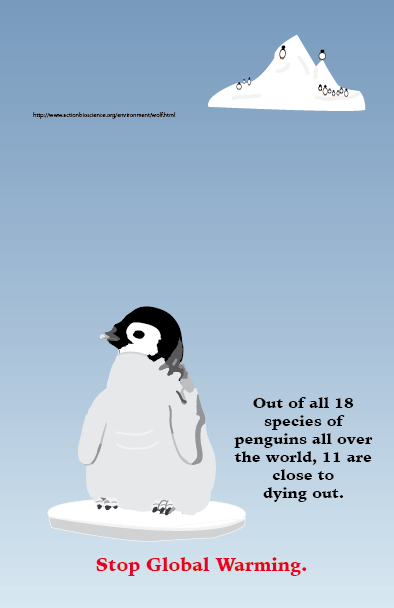Social Issue: Global Warming
It’s Getting Hot in Here!!
March 10, 2016
Regina Dominican’s graphic design class was responsible for creating a graphic poster that focused on a major social issue. Grace Tomisiea ’18 depicted the sad truth of the effects of global warming on Arctic animals and their habitats.
Global warming is an issue that is plaguing Earth because of over-consumption of fossil fuels over the last several generations. The problem is caused by greenhouse gasses that trap heat in our atmosphere and reflects back onto earth.
In more technical terms, the National Resources Defense Council defines global warming as “carbon dioxide and other air pollution that is collecting in the atmosphere like a thickening blanket, trapping the sun’s heat and causing the planet to warm up. Coal-burning power plants are the largest U.S. source of carbon dioxide pollution — they produce 2.5 billion tons every year. Automobiles, the second largest source, create nearly 1.5 billion tons of CO2 annually.”
This issue is not a dramatized heat wave. NASA states that, “ninety-seven percent of climate scientists agree that climate-warming trends over the past century are very likely due to human activities, and most of the leading scientific organizations worldwide have issued public statements endorsing this position.”
Scientific evidence for warming of the climate system is unequivocal. Many people may be aware of global warming, but they do not know fully comprehend the extent of the damage it’s causing. The United Nations Intergovernmental Panel on Climate Change (IPCC) reports that the 11 of the past 12 years have been among warmest years since 1850.
This issue is especially prevalent in the Arctic. National Geographic states that 2015 was the hottest year on record, and to make matters worse, there are predictions of an ice-free summer in 2040. NASA states that the Arctic Ocean will be entirely ice-free by the middle of this century.
Tomisiea’s graphic portrays one lone baby penguin that has been separated from its family due to the melting ice. Next to the penguin is the alarming statistic, “Out of all 18 species of penguins all over the world, 11 are close to dying out.” This visual portrays an alarming issue that evokes emotion and hopefully awareness and change.
Grace Tomisiea ’18 answered the following questions about her project:
Q. Why is this topic important to you?
A. This topic is important to me because I really like penguins and I thought it would be a unique topic that was also original visually.
Q. What are you trying to accomplish with this visual?
A. I am trying to evoke emotion out of the audience. I want people to be inspired and try to do small things to help stop global warming. My goal with this visual is to provoke a desire for change not only for penguins, but for our whole world.
Q. What was your inspiration?
A. My inspiration was an article I saw online stating how a group of penguins died due to global warming. It was the first time I was exposed to this topic, so I was shocked and passionate about the topic.
Q. Explain your visual
A. In my visual, I have a baby penguin on a small piece of ice floating in the ocean. And in the far distance, there is the penguin’s family and group. Due to global warming, penguins are separated from their family and that was what I was trying to convey.


